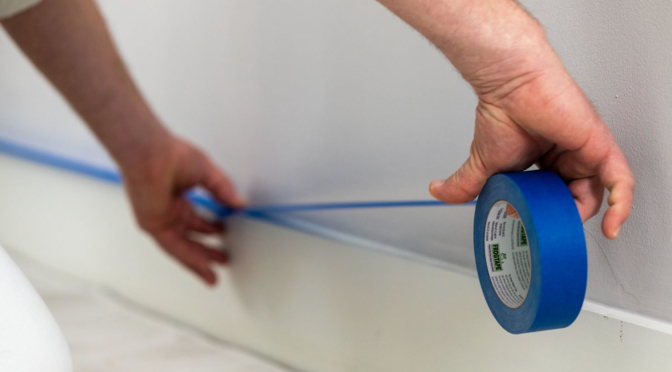6 creative ways tape can add efficiency to your work
Painting pros know a high-quality tape can deliver sharp paint lines. But on painting jobs, painter’s and masking tapes offer many more uses than their names might imply. Over the years, pros in the trades have come up with some tape hacks to boost efficiency, clean work areas and keep painting jobs on track.
While painter’s and masking tapes may seem like they can be used interchangeably, they’re not designed for the same intended applications and can create costly problems if used in the wrong circumstances.
Masking tape (typically beige in color) has stronger adhesion and is designed for general uses like bundling, labeling, and making small on-the-fly repairs, as the strong adhesion can result in surface damage. Painter’s tape (often blue in color, but also found in a variety of colors designed for different surfaces) has less aggressive adhesion and is used mainly for producing sharp paint lines or protecting surfaces, but it may not be the best choice for tasks that require a stronger hold.
Both have their place on painting jobs and should be staples in your toolbox. We checked in with painting pros for some of their favorite unconventional uses. Here’s a roundup that will help you work smarter and faster.
- Painter’s Tape: Tape the Tops
Protecting baseboards to create clean paint lines is a regular practice among painters, but Steve Lockwood—owner of Lockwood Finishes in Springfield, Illinois—has discovered another way to use painter’s tape to keep baseboards clean.
“We use painter’s tape to keep our drywall work and sanding from leaving dust or debris all over the baseboards,” says Lockwood. “Running a strip of two-inch-wide painter’s tape along the top of the baseboard creates a kind of shelf that keeps dust and paint off this area.”
Lockwood notes taping is an especially big help when baseboards aren’t being painted as part of the job, because the tape helps ensure the baseboards are protected from dust as well as paint spatter throughout the job. With a lower adhesion, painter’s tape will ensure the baseboard surface will remain undamaged.
- Painter’s Tape: Simplify Sprayer Shield Cleanup
This tape hack comes from Joe Hiera, owner of Papa Joe Paint Co. in St. Louis, Missouri. Hiera says he wraps his sprayer shield in painter’s tape before spraying because it’s easy to remove and keeps paint layers from building up, thereby extending the life of the shield.
“Once you’re done spraying, you just pull off the tape, and you have a nice, clean shield ready for the next job,” says Hiera.
- Masking Tape: Label It and Find It
We all know it’s easy to just toss gear into our work trucks after a long day, but things can get disorganized pretty quickly. Having to search for buried tools and supplies wastes time the next day or on the next job.
Use masking tape to label shelves and bins for tools and supplies, making it fast and easy to find what you need when you need it. Since the labels will remain in place longer, masking tape is a better choice than painter’s tape.
- Painter’s Tape: Organize Door Hinges for Re-Installation
Another way Lockwood uses painter’s tape is to mask door hinges, especially on projects with multiple doors that are numbered on the hinges to indicate where they’re to be installed.
“Painter’s tape is great for our numbered door hinges because it protects the hinge from spraying and leaves the door number intact on the hinge,” says Lockwood. “That way, we know where the door gets installed after it’s done being painted, and we don’t waste any time trying to figure it out.”
Painter’s tape typically has a longer clean release time than masking tape, which means it can remain on the hinges without leaving behind any messy residue after removal.
- Painter’s Tape or Masking Tape: Bundle it Up
From floor lamps to power tools, painting jobsites are full of cords and cables snaking around the floor that can easily become tripping hazards.
Wrap excess cords in tape to keep them out of the way and make jobsites safer. Use painter’s tape for temporary bundling, and for longer-term bundling, use masking tape.
- Painter’s Tape: Defy Fuzz
Fuzz from a new roller can kill the smooth finish on a wall. Wrapping a new roller in painter’s tape before painting will pull off any residual fuzz and make sure none is left behind on the wall.
Lockwood says using painter’s tape and not masking tape for de-fuzzing is important.
“Painter’s tape has a less aggressive stick,” he explains, “so it takes off just the right amount of fuzz without getting stuck fast.”
Conclusion
Small speed and efficiency gains add up. These tape hacks demonstrate how simple tools like painter’s and masking tapes can make an impact on the job, even in unconventional ways.
This article was written by Diane Walsh, VP, Market & Channel Development for Shurtape Technologies, LLC, makers of FrogTape® brand Painter’s Tape.

